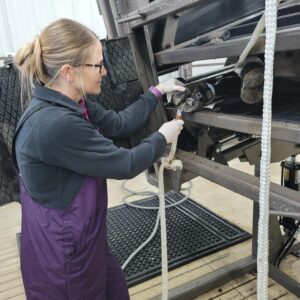 Our veterinarians can work on livestock in all 3 of our clinics or make calls to farms that have adequate facilities for sorting and confining livestock.
Our veterinarians can work on livestock in all 3 of our clinics or make calls to farms that have adequate facilities for sorting and confining livestock.
SERVICES INCLUDE:
- Reproductive Evaluations
Our veterinarians can diagnose pregnancy in bovines, equines and alpacas by use of ultrasound or rectal palpation. The doctors evaluate the female reproductive tract for abnormalities and ovarian structures to see where the patient is in their cycle. Pelvic measuring in heifers to predict how large a calf they can carry and when they are mature enough for their first calf is also available. - Bull Breeding Soundness Evaluations
Our veterinarians make sure your bull is in perfect form by doing a physical exam and evaluating semen quality before he is turned out for the breeding season. - Herd Health Consulting
Our veterinarians can sit down with producers to consult with them about custom vaccination and management protocols, and nutritional counseling to help make sure the herd stays healthy.  Large Animal Surgery
Large Animal Surgery
Our veterinarians perform numerous surgeries on all species. Common large animals surgeries we perform are: Caesarian sections, correction of torsion in the abomasum, hernia repairs, and castrations.- In House Laboratory
All our clinics have in-house laboratories that analyze blood for complete blood count and serum blood chemistry to check for internal organ functions and calcium, magnesium, phosphorus, and T4 levels. - USDA Testing
Whether it’s a health certificate, Coggins, tuberculosis, or brucellosis testing, all of our veterinarians are USDA Nationally Accredited and can perform tests required by the government. - Haul-in Facilities
Our clinic facilities have equine stocks and indoor hydraulic chutes that make for smooth cattle processing. Both of our hydraulic chutes tilt to the side to allow for easy foot trimming or any surgery that bovine feet may require. We have adequate pens for sorting and holding. We are able to work on any size group, from individuals, trailer loads, all the way up to semi-loads of cattle. - Portable Cattle Chute and Equine Stocks
If you are unable to bring your animals to our clinic we have a portable For-Most cattle chute with a palpation cage and equine stocks that we can haul to your farm.  Teeth Floating/Trimming
Teeth Floating/Trimming
If your horse is having problems chewing we can evaluate its teeth and float them if needed. Dr. DeMint is also able to trim alpaca teeth.- Retail Product/Prescription Sales
Both of our clinics carry large animal vaccines, prescription items, and supplies for your large animal needs. If we do not have an item that you need, let us know and we can get most items by the next day. - VFD’s (Veterinary Feed Directive)
In order to write a VFD we must have a valid-client-patient relationship and a current diagnosis of disease or condition. A VFD is now valid for 6 months. To complete a request form, follow the link below. VFD Request Information
VETERINARIAN’S ADVICE
While it may be cold outside now, in the veterinary world, we know spring will be right around the corner, so let’s start thinking about out spring-calving cows.
The biggest mistake most people make is waiting too long to vaccinate their cows with a scour vaccine. Most of your commercial scour vaccines need to be given 8-10 weeks prior to calving. This means if you calve in March, you should be getting your cows vaccinated in January. If you are doing heifers, they will need two rounds of this vaccine. Make sure to pay attention to the label of scour vaccine you are using, as the timing of this vaccine is very important. The next mistake people make is not beginning to routinely check their cows at least two weeks before they are due to start calving. If I had a dollar for every time a surprised client told me their cows were not supposed to start calving for a couple weeks, I would be able to pay off student loans. I try to remind people that the gestation period is 9 months, plus or minus a couple weeks (this also gives me a good excuse when farmers say that I was off a month aging the fetus during preg-check time).
When you do see a cow having a calf, a good rule of thumb to follow is if the cow is not making progress with delivery after 2 hours, then it’s time to catch her and see if she needs assistance. Notice I said two hours, not two days and not after you’ve seen the cow off by herself for a week or after you notice a rotten smell. Also, not after the cow has calving paralysis and can’t get up or after you are done planting for the season. If you want a live cow and calf, time can be critically important.
Make sure you have some colostrum replacer on hand before the start of calving season. If a cow has a hard delivery or if the calf is weak it may not get up and nurse right away (this always happens on Sunday’s). If you have a calf that has not gotten up and nursed in the first 6 hours, you need to give it colostrum. The earlier it gets colostrum the better, so if there is any doubt it will get up and nurse, go ahead and give it. If you are going to give the calf any scour preventative, most labels indicate to do this as soon after birth as possible. Many people will also give an injection of Multimin in the first few days of life, which is an injectable trace mineral to help with calf’s immune system.
If you’re going to catch and ear tag the calf at some point, you may want to think about banding the bull calves. If you are going to attempt that, make sure you get both testicles (no, they aren’t born with just on testicle). If you cannot count to two, then do not band your calves, leave both testicles for someone else to take care of later. And make sure to be safe during this process, as some mama cows take offense to someone coming and trying to kidnap their baby. Always remember, safety first.
If you notice your calf starting to get some scours, you will want to pay very close attention to it as these calves do not have much for reserves and they can die very quickly. The most common time for calves to develop scours is 7-10 days of age. There are a lot of pathogens that cause scours, but no matter the pathogen causing the scours, the treatment for all of them is fluids. many people want to treat with an antibiotic, but in most cases, this will not help unless the cause of scours is a bacterial infection. If the calf is still standing, I would recommend tubing with some oral electrolytes. If the calf is too weak to stand, then it will need to be treated with IV fluids by your veterinarian. Again, time is of the utmost importance when it comes to this issue.
It is a good idea to process your cow-calf pairs before you turn them out to grass for the summer. I usually recommend vaccinating calves for pneumonia, 7- way clostridial diseases, and pinkeye. Castrate the bull calves if it is not already done, and you can implant, fly tag and give an injection of Multimin. We usually recommend giving an injection of Longrange to cows and calves to help with parasite prevention. After all of this you can kick them out to pasture and not have to check them again for a good 2-3 months (just kidding. Although I have some clients that I think truly believe this).
As you can see, raising cattle is a piece of cake and everyone that does it will make a lot of money. Nothing every goes wrong, and you really don’t even need a veterinarian.
All joking aside, spring season is very busy and can be a very exhausting time of year. But, with the proper planning and good facilities (and a little bit of luck never hurts), i can be a very rewarding time of year. And as I like to say “If it was easy, everyone would be doing it.”
